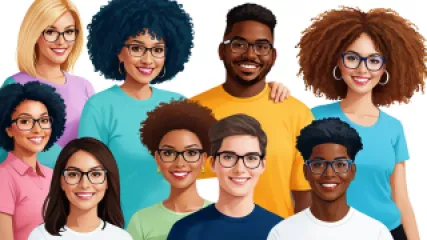The Benefits of Embracing Neurodiversity
The Benefits of Embracing Neurodiversity
In a world that often prizes uniformity and conformity, the concept of neurodiversity has gained increasing recognition and importance. Neurodiversity is the understanding that variations in the human brain and cognitive functions are a natural and valuable part of the human experience. This includes conditions like autism, ADHD, dyslexia, and other neurological differences that have traditionally been viewed as "disorders" or "disabilities." However, by embracing neurodiversity, we can unlock the immense potential and unique perspectives that come with these differences.
Embracing the Richness of Neurodiversity
Neurodiversity is not a new concept, but it has gained more attention in recent years as individuals and communities have advocated for greater understanding and acceptance. The term "neurodiversity" was coined in the late 1990s by autistic activist Judy Singer, who sought to reframe the way society views neurological differences. The core idea behind neurodiversity is that the human brain comes in a variety of forms, and that this diversity should be celebrated rather than pathologized.
At its heart, neurodiversity recognizes that there is no "normal" brain, and that the vast array of neurological variations among individuals are all valid and valuable. Chloe Mendoza, a neurodiversity advocate, explains, "Neurodiversity is about recognizing that the brain is not a one-size-fits-all proposition. We all have unique cognitive profiles, and that's a good thing. It's about celebrating the richness and diversity of human minds."
The Benefits of Embracing Neurodiversity
When we embrace neurodiversity, we unlock a wealth of benefits, both for individuals and for society as a whole. Here are just a few of the ways that embracing neurodiversity can enrich our lives:
1. Unleashing Unique Strengths and Talents
Individuals with neurological differences often possess remarkable abilities and talents that stem directly from their unique cognitive profiles. For example, many individuals on the autism spectrum have exceptional attention to detail, pattern recognition, and analytical thinking skills. These strengths can be invaluable in fields like technology, engineering, and scientific research.
Similarly, people with ADHD often demonstrate remarkable creativity, resourcefulness, and hyperfocus, which can be assets in fields like entrepreneurship, the arts, and problem-solving. Winfred Moreno, a successful entrepreneur with ADHD, says, "My ability to hyperfocus and think outside the box has been crucial to the success of my business. Embracing my ADHD has allowed me to tap into my greatest strengths."
2. Fostering Diverse Perspectives and Innovation
When we embrace neurodiversity, we unlock a diverse array of perspectives and approaches to problem-solving. Chad Carpenter, a software engineer, explains, "Working with a team that includes individuals with different neurological profiles has been a game-changer for our company. The unique ways they approach tasks and challenges have led to some of our most innovative breakthroughs."
By valuing the diverse perspectives and problem-solving strategies that come with neurodiversity, we can cultivate a culture of innovation and creativity that benefits everyone. This is particularly crucial in fields like technology, where diverse teams are more likely to develop products and solutions that cater to a wide range of users.
3. Promoting Inclusivity and Belonging
Embracing neurodiversity is not just about recognizing individual strengths and talents; it's also about creating a more inclusive and welcoming world for all. When we acknowledge and celebrate the diversity of human minds, we send a powerful message that everyone has a place and a valuable contribution to make.
For individuals with neurological differences, this sense of belonging and acceptance can be life-changing. Roselyn Hawkins, a neurodiversity advocate, shares, "Growing up, I always felt like an outsider because of my ADHD. But when I discovered the neurodiversity movement, I finally felt seen and understood. It's given me the confidence to embrace my unique strengths and to advocate for myself and others like me."
Challenging Stigma and Misconceptions
Despite the growing recognition of neurodiversity, there are still many misconceptions and stigmas that persist. Many people still view neurological differences as deficits or disorders that need to be "fixed" or "cured." This can lead to harmful and discriminatory practices, such as the over-medicalization of neurological differences, the lack of accommodations in education and employment, and the marginalization of neurodiverse individuals.
However, by embracing neurodiversity, we can challenge these harmful stereotypes and misconceptions. We can shift the narrative from one of "disability" to one of "difference" – a difference that is not only valid but also valuable. As Winfred Moreno eloquently states, "Neurodiversity is not a weakness or a flaw; it's a strength and a superpower. We need to celebrate the incredible diversity of human minds, not try to force them into a narrow definition of 'normal.'"
Practical Steps Towards Embracing Neurodiversity
Embracing neurodiversity is not just about changing our mindsets; it also requires concrete actions and initiatives to create more inclusive and supportive environments. Here are some practical steps we can take:
1. Educate Ourselves and Others
The first step towards embracing neurodiversity is to educate ourselves and others about the concept. This includes learning about the different neurological conditions that fall under the neurodiversity umbrella, understanding the unique strengths and challenges associated with each condition, and dispelling common myths and misconceptions.
By sharing this knowledge with our colleagues, friends, and family members, we can help to build a more informed and accepting society.
2. Advocate for Inclusive Policies and Practices
Embracing neurodiversity also requires advocating for inclusive policies and practices in education, employment, healthcare, and beyond. This might include pushing for accommodations and support services in the workplace, ensuring that educational curriculums and assessments are designed with neurodiversity in mind, and advocating for increased funding and resources for neurodiversity-focused research and programs.
By championing these changes, we can create more equitable and accessible environments for individuals with neurological differences.
3. Amplify Neurodiverse Voices and Experiences
Finally, embracing neurodiversity means amplifying the voices and experiences of neurodiverse individuals. This includes creating platforms for neurodiverse individuals to share their stories, highlighting their contributions and accomplishments, and elevating their perspectives on issues that affect their communities.
By giving a megaphone to neurodiverse individuals, we can challenge the dominant narratives and empower them to take charge of their own narratives.
Conclusion: A Richer, More Inclusive Future
Embracing neurodiversity is not just an act of compassion or social justice; it's also a strategic imperative for a more innovative, creative, and inclusive future. By recognizing and celebrating the diverse array of human minds, we can unlock a wealth of untapped potential and build a world where everyone can thrive.
As Chloe Mendoza eloquently stated, "Neurodiversity is not a limitation; it's a superpower. When we embrace it, we open the door to a richer, more vibrant future for all of us."
So let us embrace neurodiversity, challenge the stigmas and misconceptions, and work towards a world that celebrates the incredible diversity of human minds. The benefits are immeasurable, and the future is brighter than ever before.






